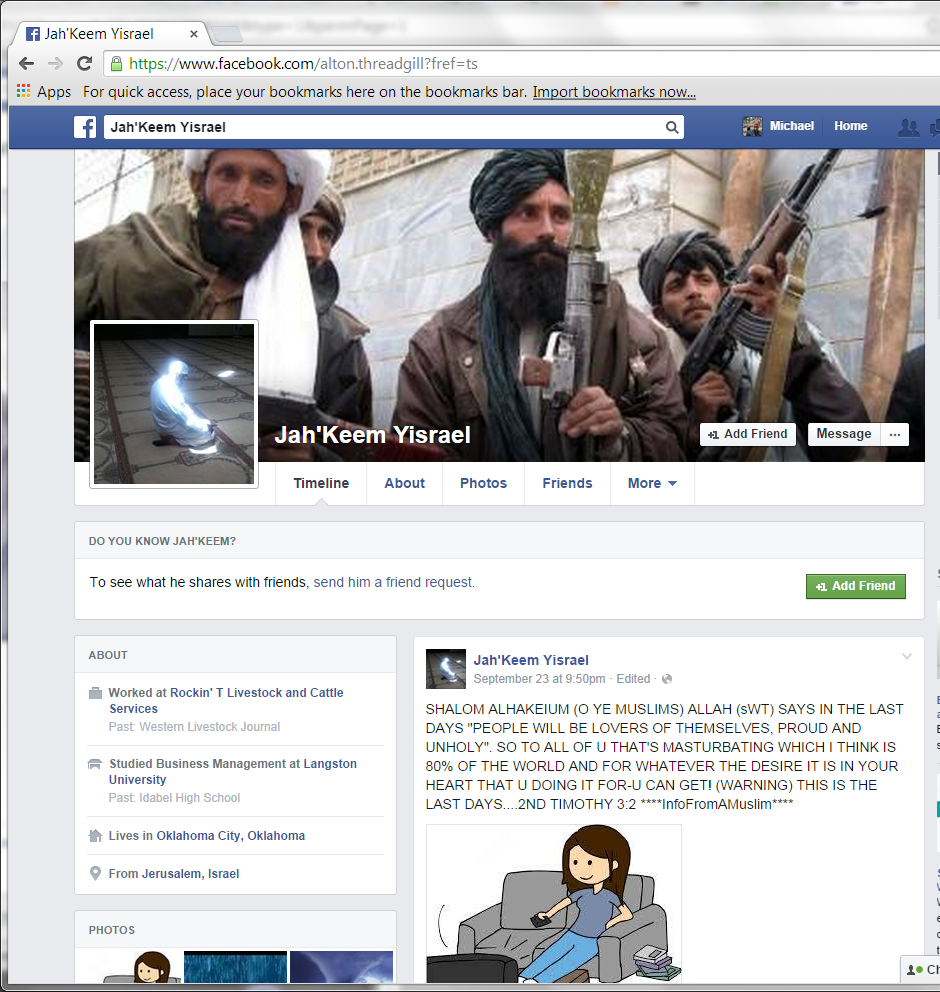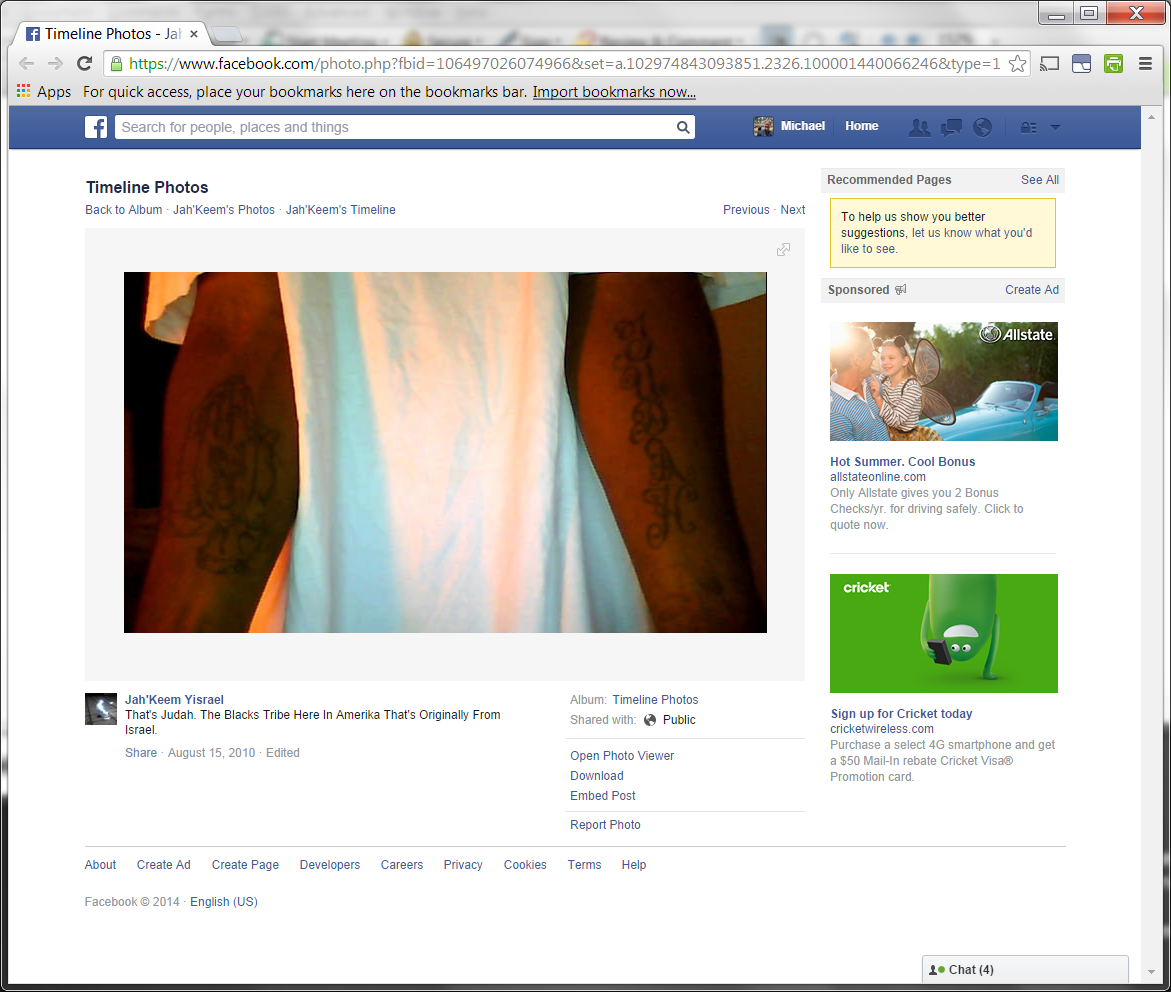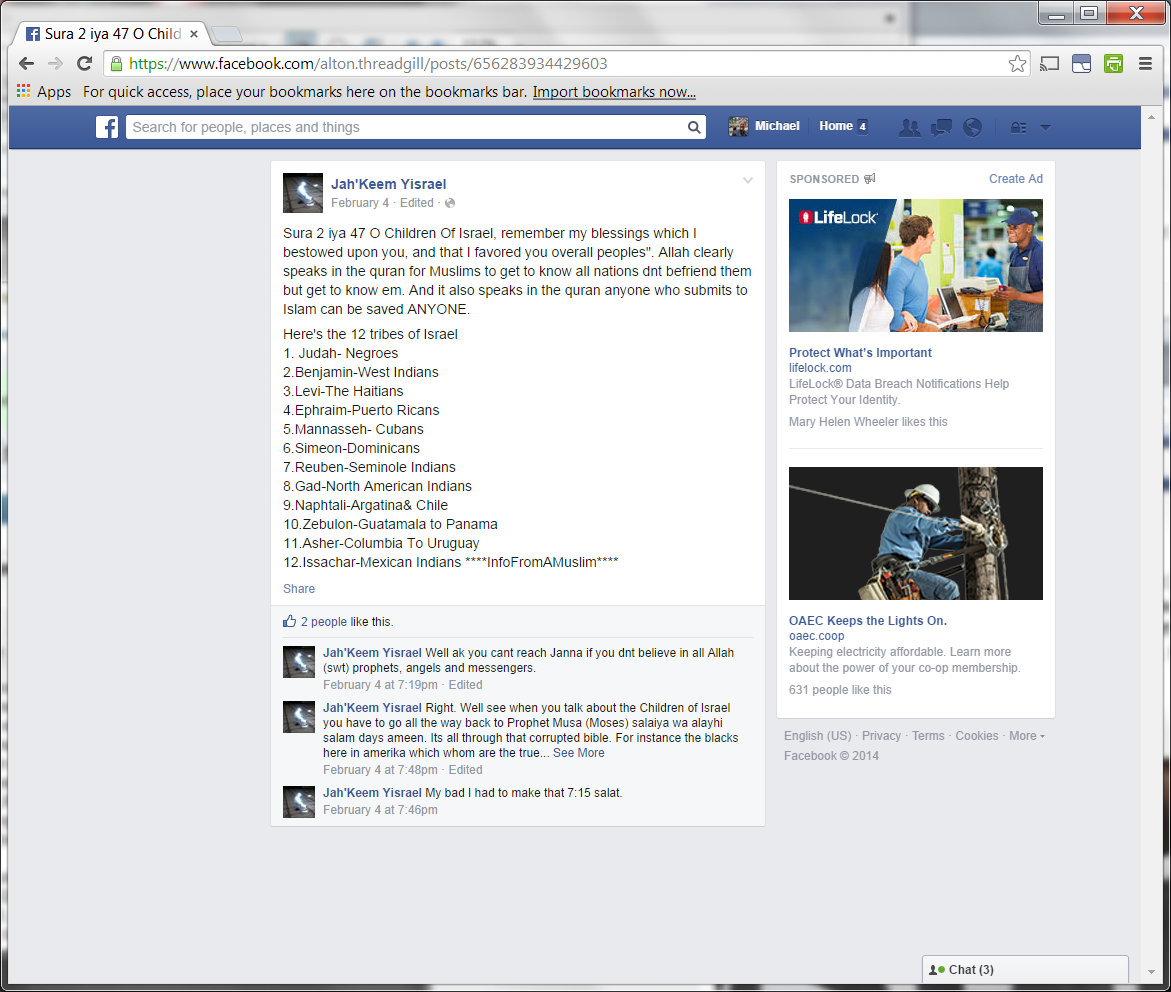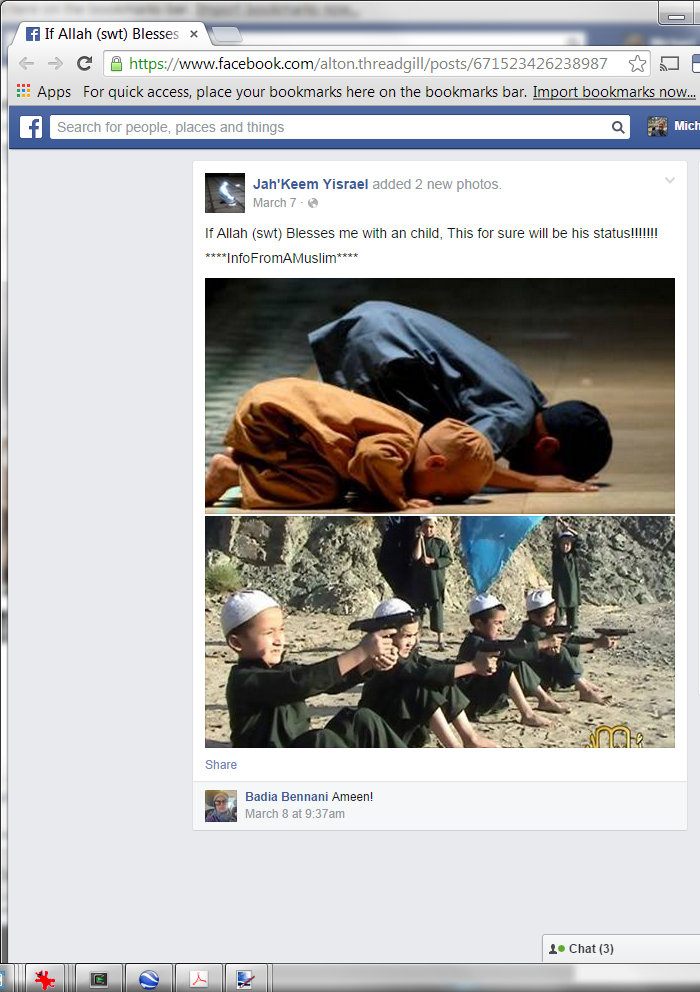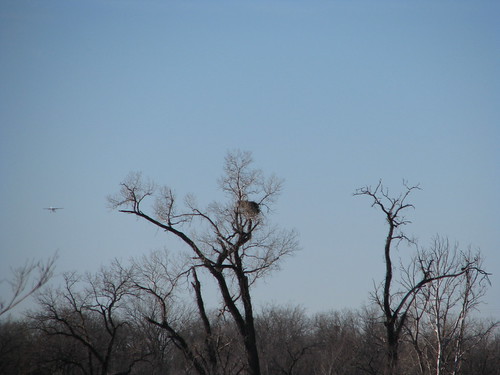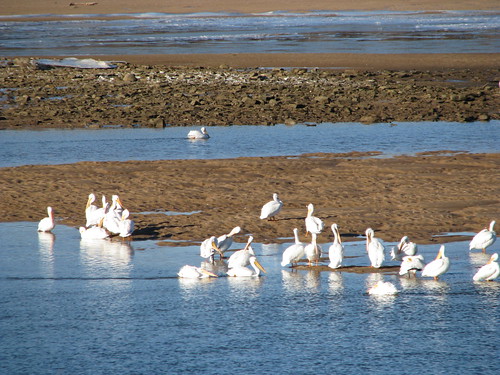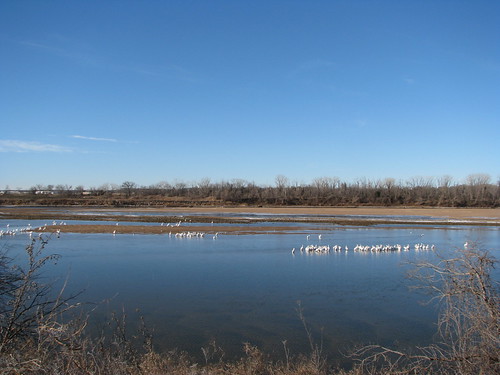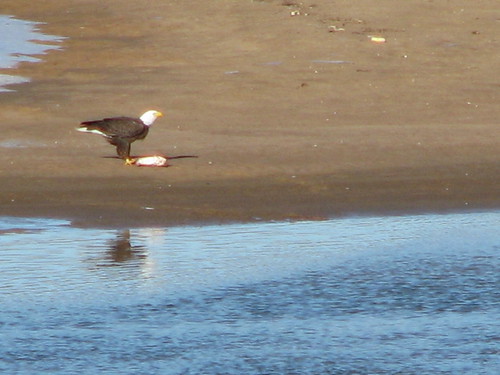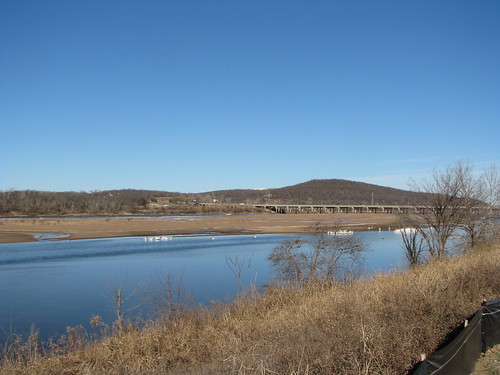September 2014 Archives
A friend posted this essay on Facebook, and I think he gets to the heart of the problem with Islam in America and the west. With his permission I'm reposting it here.
An Open Letter to Muslim Women in America
By Scott Pendleton
As a young journalist, I spent two years in Saudi Arabia. I did not dwell on a military base or in a company "compound", but in an apartment in a building otherwise occupied by a large Saudi family. I ate many meals with Saudis, including with women present. I photographed a wedding for a Saudi friend, which meant attending the evening festivity that was for women only, followed by the morning festivity for the men. In less happy circumstances, I took food to the local prison for my roommate, who had been arrested for drinking alcohol. I also witnessed an execution by stoning of a rapist/murderer.Like most Westerners living in Arabia at that time, I was eager for peaceful co-existence among Muslims, Christians, and Jews. And eager for mutual appreciation, because there is much we can appreciate about each other.
While that remains true, well-wishers and dialog-promoters in the West are often embarrassed by the coercive aspects of Islam. Coercion cannot be reconciled to nor accommodated by the laws of the United States of America. To the extent that Islam is coercive, it cannot even be regarded by Americans as a valid religion. Well-wishers hope that Islam's coercive aspects stay out of sight. That is a naïve and dangerous impulse. The coercion has to be acknowledged and addressed.
For example, Islam declares any person who abandons that religion to be deserving of death. (Like the American's wife whom Sudanese authorities had sentenced to hang.) America was founded by people who were seeking the freedom to worship as they chose, a right that is now enshrined in the First Amendment to the U.S. Constitution.
So if you are a Muslim and live in the United States, you face this dilemma: If you disagree that apostates to Islam deserve death, what are you doing in Islam? But if you agree that they should die, what are you doing in America?
Something's gotta give.
Religious coercion versus American law is a topic of vital importance for American women who are thinking of marrying a Muslim and converting to that faith. Should they ever relocate to their husband's country, they forfeit the considerable protection afforded by American law against the coercive, anti-woman dictates of Islam.
As for foreign-born Muslim women currently living in America, hopefully they have become informed that American law endows them with rights and protections unavailable to women under an Islamic government.
Does Islam really discriminate against women? Consider the Council on American-Islamic Relations (CAIR), which is a civil-rights organization that advocates prominently on behalf of Muslims. Because of the shooting of the unarmed black teenager by a white policeman in Ferguson, Missouri, CAIR issued a call for imams (preachers) to give sermons on racial equality in American mosques. That's commendable enough, though not surprising since so many immigrant Muslims are non-white.
Since CAIR weighed in on Ferguson, did it also respond to the NFL domestic violence scandal by asking imams to preach against wife-beating? No indeed, nor could it have done so, since many Muslims regard Islam as giving men explicit permission to beat their wives.
In the Koran, verse 4:34 tells how a husband who is at his wits' end over his wife's behavior may bring her back into line. Notice that, in a case of marital strife, the wife is automatically perceived as the problem, and the husband is authorized to exert discipline.
Husbands in such a dilemma are instructed by the Koran to take three steps of increasing pressure. First, try talking some sense into her. Second, stop having sex with her. Third, "daraba". This is the root of an Arabic word, kind of like "pound" or "drive" in English, which can mean anything from make a point verbally to someone, to have sex with someone, to hit someone.
Some Islamic scholars are adamant that a Muslim man may never under any circumstance hit his wives (he's allowed up to four). But the opposite view is very widely held, which is logical. Daraba in this usage wouldn't mean make a point, because that's what the husband did in step one. And it wouldn't mean have sex, because that's what he stopped doing in step two. So, for many Muslims, daraba as step three means to hit. They only debate how much force is allowed.
A Muslim woman better hope that her husband subscribes to the gentlest interpretation of daraba. Either that, or she better be living in America, where the law of the land trumps Islam.
Oklahoma State Sen. John Bennett caused a stir when he called Islam a cancer that must be cut out of America. I disagree. It is really Muslims residing in America who must cut out the cancer, the cancer of coercion, from their religion. They must speak up. They must repudiate those elements of Islam that are irreconcilable to American law. It's not merely a question of denouncing the beheading of innocent journalists. It's everything in Islam that makes an individual feel divinely empowered to judge and punish others - husbands over wives, the faithful over apostates.
Unless that repudiation is voluntarily, publicly, consistently forthcoming, then dialog with Muslims is out of the question. America is the land of the free.
MORE:
For your reference, here is a link to three parallel English translations of the Qu'ran. Sura 4 contains the verse Pendleton mentions above.
Pendleton's caution to American women considering marrying a Muslim, converting, and moving back to the husband's country brings to mind the story of Betty Mahmoody and six-year-old daughter Mahtob, whose escape from revolutionary Iran was recounted in the 1991 movie "Not without My Daughter." That link connects to the "Reel Faces" website, which compares films to the true stories behind them.
Tattoo photos in the Facebook profile of someone calling himself Jah'Keem Yisrael matches tattoos named in the Department of Corrections record of Alton Alexander Nolen, the man eyewitnesses say beheaded a worker at a food processing plant in Moore, Oklahoma, on Thursday.
A number of websites uncovered the profile and suggested that it belonged to Nolen. Like Nolen, Yisrael graduated from Idabel High School and went to Langston University for college. The "selfies" in the profile strongly resemble the Oklahoma Department of Corrections mugshots of Nolen. But there has been some doubt, because the the profile uses "alton.threadgill" in the custom URL.
The Facebook profile shows an intensifying interest in Islam over the last year or so, praises Osama bin Laden, includes a cover photo of heavily armed Taliban, and praises sharia law and beheading.
But a photo in Jah'Keem Yisrael's August 15, 2010, Facebook post shows a man (apparently the owner of the Facebook profile) with arm tattoos that match the DOC's records for Nolen. (Click to see full size.) The left forearm shows the word "JUDAH" in script capitals. The right forearm shows a tattoo of praying hands.
The DOC record for Alton A Nolen, DOB 08/16/1984, lists the following "Body Marks":
TAT ABDOM: NCIC AS-SALAAMU ATAIKUM
TAT CHEST: NCIC JESUS CHRIST
TAT L ARM: NCIC RIP LIL KRIS, JUDAH
TAT R ARM: NCIC PRAYING HANDS
The gaps in Jah'Keem Yisrael's Facebook timeline match up with the DOC record. No posts from September 20, 2010, until August 23, 2012, when he writes, "Feelin So Gud 2 B N Da City At Da Halway House....At dis moment im walkin round wit my shirt off n boi boi lol Yeh jst got thru job untin and she said sho my chest." The tone of his posts is in that vein until April 3, 2013, when he posts, "Allahu Aikbar Allahu Aikbar....." After about October, the posts are almost exclusively Islamic-themed.
Another confirmation of the tattoo: In a February 5, 2014, post, Jah'Keem Yisrael writes that the Twelve Tribes of Israel are today black Africans, Latin Americans, and American Indians and says in a comment (evidently responding to someone whose comments are not visible to the public),
The true jews that's here in Amerika today known as the black man was sold to the white man by the Africans because we weren't from there. Were from Israel. The Roman persecution put an end to the biblical jews known as the tribe of Judah which is tatted on my left forearm lol.
Among the more alarming recent Facebook entries:
On March 7, 2014, Jah'Keem Yisrael posted a set of three photos, writing:
Sharia Law will takeover (aka) Allah swt Law -Matthew 5:30 Cut the hands off the thieves, Deuteronomy 22:23-24 Stone to death the adulters, Any woman showing her hair in public must be shaved off 1st Corithians 11:5-7.. If your against the Sharia Law your against God. Now you know what freedom u guys are fighting for.
Islam is the true religion
****InfoFromAMuslim****
The photos include a man holding a newspaper headline, "Islam will dominate the world / Freedom can go to hell", a graphic photo of a decapitation, and a photo of a woman in white middle-eastern dress being whipped in public by a hooded figure in black. (Click the links to view a screenshot of these photos posted to Facebook. WARNING: Photos are graphic.) The caption embedded in the decapitation photo reads,
Thus do we find the clear precedent that explains the peculiar penchant of Islamic terrorists to behead their victims: it is merely another precedent bestowed by their << Prophet >>:"I will instill terror into the hearts of the Unbelievers: smite ye above their necks and smite all their finger-tips off them." Qur'an 8:9-13
On the same date, he posted two more photos, one showing two boys prostrating themselves in prayer, the other showing four young boys in white head-coverings firing handguns.
He wrote:
If Allah (swt) Blesses me with an child, This for sure will be his status!!!!!!!
On March 30, 2014, he posted a salute to Osama bin Laden, writing:
"Do not say that those slain in the cause of God are dead. (They are alive, but you are not aware of them)" (2:154).Osama Bin Laden (Salayi Wa Alayi Salaam Ameen)
****InfoFromAMuslim****
The phrase in parentheses seems to be some form of the Arabic phrase meaning "Peace Be upon Him," a phrase often used in connection with Muhammad and other prophets.
We all liked the Gathering Place when it was a private institution pursuing a project on private property, but maybe it isn't so likable now when it's damaging public right-of-way for walkers, runners, and cyclists:
Most of the Midland Valley Trail will remain open, but its connection to the river will be severed as A Gathering Place for Tulsa construction gets underway.The trail will be blocked off south of 26th Street to Riverside Drive until the first phase of construction is completed in 2017, planning officials said. It is portion of the trail that runs beside the former Blair Mansion property....
The Gathering Place property straddles the trail, and Stave [sic] didn't see how ongoing construction could keep it open to the public.
According to county assessor records, the trail is owned by the State of Oklahoma Department of Highways. The trail replaced the tracks of the Midland Valley Railroad. The state bought the rail line and right-of-way for construction of the Riverside Expressway, which would have left the Riverside corridor at that point, following the MVRR right-of-way to connect to the southeast interchange of the Inner Dispersal Loop. The Riverside Expressway plan was dropped in the 1970s in response to protests and lawsuits from Maple Ridge homeowners.
Although the closing of the trail will happen this week, the trail along Riverside Drive that connects to the walking bridge will remain open until the middle of 2015.Stava said Riverside Drive construction will then shut down the affected portions of the River Parks East Trail along Riverside Drive.
The pedestrian bridge across the Arkansas River will also be shutdown in mid-2015 because pedestrians will have no place to go when crossing it from the west side, he said.
It's not said explicitly in the article, but the implication is that the bridge and east bank trail will also be closed until the end of the first phase of construction in 2017. That will create three dead-ends for our trail system -- the east bank trail approaching from the south, the east bank trail approaching from the north, and the Midland Valley trail -- and eliminate one of the easy loops around the river.
I wouldn't be surprised to learn that some Tulsans use the east bank and Midland Valley trails to commute to work.
During highway construction, contractors do their best to allow traffic to continue, with at least one lane in each direction. Shouldn't cyclists and joggers get the same courtesy?
As a private institution, the George Kaiser Family Foundation can't shut down public roads or rights-of-way on its own initiative. So who in city or state government granted permission?
UPDATE: A reader who commutes by bicycle writes:
You mentioned that you "wouldn't be surprised" that some Tulsans use it to commute to work. That's me.For the last two years, I have ridden my bike from our house at 37th and Riverside down to the River trail, across Riverside on the Pedestrian Bridge, and into downtown on the Midland Valley trail. Lately I have added a stop at the Forge gym at 3rd and Peoria to my route before work, as I can make it to within a block or two using the north end of that trail. It is safe and keeps me off of the rush hour streets.
There are several other bikers I see every morning with backpacks like mine, clearly headed to work. It is our commuter street, and it's being completely shut down for 3 years. I can route around the closed portion, but for me it means I will have to cross Riverside at street level at 31st, cut to Boston Place, go north through Maple Ridge to 26th, then west to get back to the trail. If they close 31st at Riverside for the construction office, it will make it even more challenging. I would otherwise cut through the apartment complexes on Cincinnati (the only through street to get to 31st besides going up Peoria), but when they start demolition of the complexes in January they will undoubtedly close off some of that.
So who gave them permission? Good question.
Good point about the apartment complexes. Cincinnati Ave. is the only place to cross Crow Creek between Riverside and Peoria, the only connection between Maple Ridge and the northern residential part of Brookside to the Brookside commercial district that is safe and comfortable for pedestrians and cyclists. The Legacy at Riverview (formerly Place One) sits on both sides of Cincinnati just south of the Crow Creek bridge. The city ought to insist that this public street be kept open during demolition and construction, but given their apparent readiness to close public rights-of-way for three years for the benefit of a private project, I have a feeling the city won't press the issue with GKFF.
Rob Asghar, writing in Forbes, offers some noteworthy insights about organizations, accountability, and game-changing leaders. Asghar calls Mark Driscoll's Mars Hill Church, the "Enron of American churches":
In life, blowhards and bullies will inevitably rise up and do their thing. In the field of management, they tend to rise up and do it with extra frequency and impact. And in religious organizations, they can often do it with maximum impact, because the whole enterprise is usually founded on the notion of absolute authority....Nondenominational megachurches... often can be free-wheeling, Wild West-style operations, unencumbered by national bureaucracies. That frees them to respond to grow quickly ... or to grow malignantly.
Gautaum Mukunda, author of Indispensable: When Leaders Really Matter, has noted that most leaders in most industries are "filtered" by a sorting-and-screening system specific to their profession. But a few are "unfiltered," and may get into a major leadership job without first being scrutinized as closely. The latter, unfiltered leaders are what he calls "extreme leaders"--the game changers, for better and for worse. But in most cases, the nutjobs and the geniuses are alike filtered out by the system....
Personality cults end badly, because anyone objective finds themselves mauled by loyalists trying to hold the cult together. (Eric Hoffer's The True Believer remains a pivotal resource for understanding the motivations of cult-type personalities, who often have their entire identities fused into their nation, organization or holy cause.)...
But a number of psychologists have told me that the truly toxic leaders, the ones who manage to cause trouble on the scale of a Driscoll, are tragically irredeemable as managers. Oftentimes, the disciplining process only teaches them new ways to exploit the system while pretending to obey it.
Redemption for these fallen stars, Asghar writes, doesn't happen by getting back in the spotlight but "by finding some way to be of productive service without being in charge of large budgets and large communities." (John Profumo comes to mind as the model of a fallen leader who devoted himself to service and never sought a return to power.)
Asghar confesses "a strong revulsion for the bullying and sociopathy that happen far too often within the world of management" -- particularly in the spiritual realm. Why do these sorts of situations happen again and again?
In another article about Driscoll and Mars Hill Church, Asghar writes that toxic followers enable toxic leaders:
Some years ago, former Los Angeles Times religion writer William Lobdell wrote about his experiences covering the sexual abuse scandals of the Catholic Church. Lobdell shared that what broke his spirit wasn't the way the church leaders refused to see the truth, but rather the way the ordinary laypersons refused to see it-how they shouted down peers bold enough to speak honestly about their traumas, how they sought to rationalize any evil done by their beloved leaders.That's one crucial aspect of the link between toxic leaders and followers. In the case of megachurches, there's also the appeal of protecting one's part in a big, impressive show -- like being a regular at the cool club that everyone talks about. The star of the show is usually an uber-charismatic, dramatic salesperson. Like the brash and humorous Driscoll.
Narcissism sells. People rally around it, even when they should know better. But as Jim Collins showed in From Good to Great, the leaders of the healthiest and strongest organizations ("Level 5 leaders") are generally the antithesis of the high-drama, high-celebrity leader.
"We had no idea what was going on" isn't a valid excuse on the part of followers in most cases of toxic leaders. Many followers too eagerly forgive a toxic leader's obvious discretions because they're charmed by the leader's offsetting charms. Until it's too late.
This Phil Johnson sermon is about the prosperity gospel, but these paragraphs are a broader indictment of modern evangelicalism and could as easily apply to non-charismatic megachurch leaders and the parishoners who enable them:
Unless you live in total isolation and never read any news about the church and our testimony to the wider world, you must be aware that the evangelical movement worldwide is currently undergoing a doctrinal and philosophical meltdown of catastrophic proportions. By any measure you could possibly employ, the evangelical movement right now is more backslidden and more spiritually bankrupt than medieval Catholicism was just before the dawn of the Protestant Reformation. The evangelical movement of our generation has become a monstrosity. Doctrinal, moral, and political corruption are the rule rather than the exception -- and some of the largest and most visible evangelical and charismatic churches today are populated with people who absolutely love to have it that way. They don't want to hear any criticism or complaint about worldliness or bad doctrine. Their religion is all about self-aggrandizement, and they will not tolerate anyone who points that out.Churches worldwide are full of people who aren't the least bit interested in scripture, or doctrine, or truthfulness. They just want to have a good experience and feel good about themselves. More than that, they want to hear that God feels good about them, and that He exists to do their bidding. And when someone comes along with any kind of critique that questions what they are doing or what they are teaching, that interrupts the illusion of well-being they have cultivated so carefully. So the average evangelical nowadays is tolerant of just about everything that happens in the church. The only thing evangelicals cannot abide is someone who keeps calling the church back to biblical faithfulness. Discernment is the one spiritual gift no one seems to want to practice or even hear about.
MORE: An explanation of toxic leadership, particularly in the political realm: Political Ponerology by Andrew Lobaczewski.
Tomorrow morning (Friday, September 19, 2014) at 8:05 am, I'll be on 1170 KFAQ with Pat Campbell to discuss "improvements" to the Arkansas River, the broad prairie stream that flows through the western and southwestern parts of the city of Tulsa. The "improvements" would involve renovating the Zink Lake dam, built in 1980, and building three new dams to fill the river to its banks, for a total cost estimated at $240 million. (UPDATE: Here's the audio of my KFAQ interview with Pat Campbell.)
Earlier this month, friends and fans paid their final respects to comedian Joan Rivers. She was a groundbreaker for women in stand-up comedy, Johnny Carson's long-time backup host on the Tonight Show and then his competitor, a survivor of personal and financial tragedy who made an impressive comeback, and a staunch supporter of Israel's right to exist.
But Joan Rivers may be best known, particularly among the younger generation, for her frequent trips to the plastic surgeon. Rivers demolished her natural beauty in pursuit of an elusive ideal and spent a fortune only to end up looking harsh, alien, and artificial.
What drives an attractive woman to undergo one expensive and risky elective surgery after another? The obvious cause is insecurity, low self-esteem. She must have been convinced that she could only be attractive if she drastically altered her appearance, and evidently no one could convince her otherwise.
You could ask the same question about cities. Why would a beautiful city pursue risky and expensive plastic surgery in pursuit of artificial enhancements that ultimately fail to increase the city's charm and appeal?
Whether Hollywood star or Midwestern city, the drive for extreme surgical makeovers betrays a lack of self-confidence and a break with reality. Many a city tore down charming Victorian or Craftsman homes for brutalist public housing towers. After World War II, owners of Art Deco and Romanesque Revival commercial buildings were persuaded to cover their facades with metal cladding, in order to look "modern" and "up-to-date." Decades later, building owners are tearing off the cladding to put the unique elements of each building on view once again.
Our consumption-driven economy thrives on insecurity and discontent. An unscrupulous plastic surgeon could boost his bottom line by persuading potential patients that they're hideous without his help. Heavy construction companies, civil engineering firms, and bond advisors and attorneys can benefit financially by persuading voters that their city is too ugly to attract residents and visitors, but paying them hundreds of millions of dollars will make the city presentable -- at least until it's time for the next nine-figure tax package.
Conventional wisdom is conventional, and the conventional wisdom about the Arkansas River is that it's ugly and no one wants to be around it because it isn't filled with water from bank to bank. If we want to have development along the river, the conventional wisdom goes, we need to ensure that there's water in the river by building new low-water dams and fixing the one we already have. And we have to have development along the river if we want to attract the kinds of young hipsters that pick where they want to live and then look for a job.
We have water in the river. What seems to annoy people is that we also have sandbars and shelves of shale that are visible when the water level is low. If only we would spend hundreds of millions of dollars to build dams, we could raise the water level by a few feet and spare visitors the hideous sight of our sandbars. They they will like us and spend money here -- or so the deluded, insecure thinking goes.
But some of Tulsa's visitors really like our sandbars.
Wildlife in the river bed more interesting than a river full of water
On a frosty morning twenty-five years ago this January 21, I took my girlfriend to the Audubon Society's bald eagle watch. (Later that day I proposed to her.) At the time, we were amazed to realize that just 20 miles from downtown Tulsa you could watch our once-endangered national symbol in the wild. Earlier this year, in commemoration of that auspicious day, I took my family to the Audubon Society's bald eagle watch.
In 1989, the Audubon Society set up their eagle watch just below Keystone Dam. The eagles seemed to prefer the shallow waters below the dam to the deep and broad expanse of the lake above the dam.
In 2014, the Audubon Society set up their eagle watch in Helmerich Park, on the east bank of the river south of the 71st Street bridge. Over the years the eagles had extended their range downriver and into the City of Tulsa itself. We watched bald eagles come and go from a nest across the river on the west bank, notwithstanding the proximity of Jones Riverside Airport.
Click on the photos to enlarge.
We saw bald eagles, both white-headed adults and black-headed juveniles, soar above the river and dive down in search of a meal. And we saw hundreds of white pelicans.
As you can see from the photos, the pelicans preferred to roost in the shallows where the sandbars met the river or in shallow places where the sandbars were barely submerged.
The bald eagles liked the sandbars as well. We watched one mature bald eagle eating a fish on a sandbar, not far from a rivulet that crossed the sandbar to connect two branches of the main stream.
A gull tried to snatch the eagle's catch.
But the eagle waved him away.
A little while later, the adult was replaced by a juvenile, working on the same fish on the same sandbar.
This was the view of the Arkansas River from Helmerich Park on January 25, 2014, looking northwest toward the 71st Street bridge and Turkey Mountain. This is boring? This is ugly?
But instead of the shifting patterns of water and sand and the variety of wildlife, some Tulsans are adamant that we need a flat, monotonous expanse of water from shore to shore so that we can feel pretty.
What do we think "water in the river" will do for us?
When Tulsans enthuse about the impact of water in the river on tourism and economic development, they inevitably mention San Antonio's River Walk. The San Antonio River, as it bends through downtown, is about 40 feet wide -- about the width of a two-lane street. You can easily cross from one side to the other. You can easily spot someone you know on the other side and call out and wave. The Arkansas River through Tulsa ranges about 1000 to 1600 feet wide -- twenty-five to forty times wider.
In 2006, Canadian architect Bing Thom, hired by Tulsa's Warren family, proposed a way to create the River Walk feel: Excavate much of the west bank between 11th and 21st Streets, build an island with shopping and high-rise housing near to the east bank, with a little channel about the width of the San Antonio River separating it from the east bank. Price tag to the taxpayers would have been at least $600 million. Building housing in the river's floodway was unlikely to get Corps of Engineers approval. Excavating the west bank, once the site of oil refineries, might mean dredging up toxic materials now buried and settled.
If you want a street's-width River Walk, a better bet might be to follow OKC's lead and actually replace a street with a canal. Or tame one of our larger creeks and put development alongside. Combining the two ideas, the Elm Creek Master Drainage Plan includes a canal running down the middle of 6th Street east of Peoria. Many years ago, an architect proposed exposing the lower reach of buried Elm Creek, near 18th and Boston, for a creekside promenade.
Perhaps the water-in-the-river fanatics are thinking about the pleasures of watching the sun drop into the Pacific at nightfall. You really need at least 20 miles of open water to get that effect. That would mean excavating a lot more than the River West Festival Park. We'd have to flood Red Fork and turn Lookout Mountain into an island.
Maybe it's a reflecting pool that they want, so that motorists crossing the river on I-44 can spend some of their 15 seconds on the bridge looking north to see the skyline reflected in the river, just like that Ken Johnston painting. But even in that painting the water is rippled by the wind, as tends to happen with a broad, open expanse of water.
Do they think more dams on the river will bring about more recreation on the river? It's doubtful. Zink Lake has been around for over 30 years. The ferry boats and sailboats in mid-'70s "artist's conceptions" never materialized. Silt and sand don't let the water get too deep. We haven't even seen paddle boats on Zink Lake. Some number, probably not more than 100, participate in rowing on the river. I suspect more Tulsans had been on the river during the 1970s heyday of the Great Raft Race, prior to the completion of Zink Dam, than in the years since.
For a few years, Steve Smith ran airboat tours and then occasional guided canoe trips on the Arkansas River between Zink Dam and Keystone Dam. If I recall correctly, he tended to attract more out-of-town visitors who saw his brochure in the rack in the hotel lobby than locals. His descriptions of his tours, which you can find various places around the web, emphasize the variety you can see from the river -- wildlife, shoreline, little islands. But as far as I can find, he's no longer in that business.
Oklahoma City, Austin, and Wichita all have dammed, brimful rivers, but none of them have attracted vibrant riverfront development. The excitement in those cities is to be found in walkable neighborhoods of historic buildings away from the river.
We have a beautiful river. It needs some cleanup in places. The levees may need repair -- but that's a public safety and stormwater control matter, and we shouldn't let city leaders logroll elective cosmetic surgery in the same tax issue as a necessity. Let's stop listening to the hack plastic surgeons who want us to feel insecure enough to pay them hundreds of millions of dollars to "make us pretty." Let's appreciate the God-given beauty we already possess and the wildlife that enjoys it, in its changing variety.
MORE:
The BatesLine archive of stories about the Arkansas River.
David Schuttler has some beautiful wintertime video of pelicans and herons from the stretch of the river west of Sand Springs:
John Eagleton writes to inform me that, after my appearance on KFAQ, all the "tax-and-spend hooligans" are angry with me. Sicut erat in principio, et nunc, et semper, et in saeculi saeculorum. Amen.
Charles Hardt, former City of Tulsa Director of Public Works, opposes building dams and encouraging development along the river. He says the 100-year-flood standard isn't stringent enough when it comes to the damage a river flood can do. Hardt's training is as a hydrologist, and he led the city's massive stormwater mitigation efforts following major floods in 1984 and 1986.
"We are talking about adding more things to the river banks — and potentially in the river — that could make the flooding worse and create the potential for a lot more loss of life and more property damages," he said.Hardt said development in and along the river can act as a "plug" that impedes the natural flow of the river —-- a flow that in times of heavy rainfall scours the river's bottom and banks to increase the river's capacity.
"You're encouraging development that is not compatible with the river's function, and that is to carry the water from upstream to downstream," he said....
Hardt's not just worried about the dams that might be built in the river. He's concerned about one that already exists --— Keystone Dam, and he would like to see a major push to study and repair Corps infrastructure projects.
"Its effectiveness and the maintenance of it and what its capabilities are needs to be well understood before we put other things downstream from it —-- other things meaning low-water dams, development along the river," Hardt said.
Polls are now closed in Scotland, but it will be several hours until all the votes are counted in the referendum to decide whether its 307-year-old membership in the United Kingdom will be dissolved in favor of independence. The question on the ballot is simple: "Should Scotland be an independent country?"
Paul Monies, a Scotsman and British subject who reports on energy news for the Oklahoman, offers a summary of the arguments for and against and offers his own opinion and prediction:
Scotland's vote Thursday on a referendum for independence has been cast as a choice between the head and the heart.The heart says the nation of 5.3 million people is strong enough and confident enough to dissolve the 307-year-old union it has with England and the rest of the United Kingdom. The head says the economic risks are too great for a small country in the global economy....
The No campaign, which calls itself "Better Together," says breaking up a political and monetary union will be messy, and the Yes campaign hasn't offered enough concrete details on how it will happen. Pensions, splitting up the U.K.'s national debt and how an independent Scotland will continue to use the pound as its currency are among the issues to be negotiated if Scots vote Yes.
Results will be tabulated and reported by each of Scotland's 32 local government areas. I don't think individual polling place results will be reported. According to Oliver O'Brien's map of estimated declaration times, first results are expected at 2 a.m. BST (8 p.m. Tulsa time) from Perth & Kinross, Moray, North Lanarkshire, East Lothian, the Western Isles, and the Orkneys. The big cities will declare a result at 5 a.m. BST.
You can listen to BBC Radio 4's coverage of the Scottish referendum results live online starting at 4 pm Thursday Tulsa time.
#indyref is the Twitter hashtag.
MORE:
Cute bit of satire: The USA writes an open letter, calling on Scotland to show a "decent respect for the opinions of mankind."
Peter Hanraty, vice president of Oklahoma's constitutional convention and mining safety activist, was an immigrant from Scotland.
The Telegraph has a series of photos of Scottish referendum demonstrations and campaign activities:
Former Labour PM Gordon Brown campaigns for maintaining the union. He looks more than a bit like the late comic actor Tony Hancock. "Does Magna Carta mean nothing to you? Did she die in vain?"
This young man had the best protest sign: "My dad made me come here!"
Market Force Information polled over 5,000 consumers for a study of convenience store preferences. Tulsa-based QuikTrip had the highest "Composite Loyalty Score" at 79%, followed closely at 74% by Wawa, a 645-store chain founded 50 years ago in the Pennsylvania township of the same name and dominant in the mid-Atlantic states. QuikTrip has over 700 stores in and around Tulsa, Wichita, Kansas City, Omaha, Des Moines, St. Louis, Dallas/Fort Worth, Phoenix, and from Atlanta to Charlotte along the I-85 corridor.
QuikTrip had the highest ratings for friendly service, fast service, cleanliness (inside, outside, and restrooms), and high quality beverage station, with over two-thirds of respondents agreeing that those descriptions fit QuikTrip stores. QT also topped the "inviting atmosphere" category, but only with 51%.
Wawa finished second or third to QuikTrip in those categories, but topped QT in high quality coffee (Wawa 54%, QT 37%), high quality food (Wawa 42%, QuikTrip in 4th at 26%), and available amenities (Wawa 36%, QuikTrip in 5th at 22%).
In the food selection category, Sheetz, a 437-store chain in Pennsylvania, Ohio, West Virginia, Virginia, Maryland, and North Carolina, finished first with 54%, followed by Wawa at 49% and QT at 36%. Sheetz offers burgers, wings, wraps, pizza, burritos, and subs through a touchscreen ordering system.
Wawa Inc. started as an iron foundry in 1803, which launched a dairy in 1902, which opened small food markets to sell its products in 1964. Two years ago Wawa began expanding into the Orlando and Tampa metro areas in Florida, and newer, bigger, fuel-oriented stores are replacing older non-fuel locations in eastern Pennsylvania, Delaware, New Jersey, Maryland, and Virginia. Wawa is known for its wide variety of coffees and its built-to-order hoagie counter. As with QuikTrip, you expect Wawa stores to be clean and orderly. A couple of favorite features:
(1) To doctor your coffee, Wawa has quart cartons of its dairy's milk and half-and-half in a chilled well set into the coffee counter.
(2) For customers on low-carb diets, Wawa offers lidded snack cups filled with cheese cubes and pepperoni slices or carrot and celery sticks -- healthier alternatives to donut hole snack cups.
As far as I can tell, QT, Wawa, and Sheetz are not in any overlapping markets.
So congratulations to hometown QuikTrip, and we hope QT's spirit of innovation will spur them on to further improvements -- especially in the coffee department.
MORE: Sheetz, Wawa, QuickCheck (138 stores in New York and New Jersey), and QuikTrip are the top four in Facebook "likes" per store.
NOTE: The Kickstarter campaign to bring the Urban Tulsa Weekly archive back online has just three more days to run. We need $875 more in pledges to move forward. If you'd like to see this irreplaceable archive of a period of Tulsa history accessible online again, please make a pledge.
UPDATE: 2014/09/17: Raised a bunch yesterday. Now only $560 more in pledges needed to make this happen. Please make a pledge today.
UPDATE: 2014/09/19: We got close, but didn't quite make it -- $535 in pledges out of $1,000 needed. I waited too long to promote it and didn't set the pledge period long enough -- and you can't change it once the Kickstarter has been launched. We may try again, and I'm open to suggestions for how to do it better next time.
Urban Tulsa Weekly ceased publication in November 2013 after over 20 years as Tulsa's alternative newspaper. A few months later its web presence, UrbanTulsa.com, went offline, and with it went seven years of Tulsa's history. In its final incarnation, the site held the newspaper's stories from 2006 to 2013.
Urban Tulsa Weekly's writers covered indie music, art, and theater, local eateries and nightspots, sports, business, urban development, and local politics. The paper was often the first to report on new stars, new bands, and new trends. Without the stories and perspectives found in UTW, Tulsa's historical record is incomplete.
Since the website has gone offline, we've gone to the Internet Archive Wayback Machine looking for UTW stories that have become timely again, but we've found to our dismay that many of them were missed by the Internet Archive's webcrawlers. A group of former UTW writers is banding together to restore this piece of Tulsa history to the internet, and we need your help.
While I have all of the columns and stories that I submitted for publication (and retained the rights to republish them -- eventually I'll get them all online here), the same is not true of many other great writers and editors who contributed valuable insights on the state of Tulsa, Oklahoma -- its politics, sports, music, arts, and entertainment.
The good news is that, with the publisher's permission (which we have), the hosting provider can quickly put the UrbanTulsa.com archive back online and keep it online in a frozen, archive-only, ad-free state -- but there's a price. This Kickstarter will cover the initial cost of restoring the archive and keeping it online for three months.
During that initial period, we hope to get a complete scan from the Internet Archive, and we will be working on affordable ways to maintain the UrbanTulsa.com archive online in the long run. Funds above our initial goal will pay for additional months of hosting. With sufficient funding, access, and permission, we'd like to get the entire run of the paper online in some form.
Because we are not permitted to sell ads to support the site, we need your financial support to make this happen. Help restore and preserve this significant record of Tulsa's recent history with your pledge today.
Lately, for the eight-year-old's bedtime story, I have been reading the book Peace Child by Don Richardson. In 1962, Richardson, his wife Carol, and their infant son went with Regions Beyond Missionary Union to the Sawi, a people who live in the sago palm swamps along the Kronkel River in what was then Netherlands New Guinea, now the Indonesian half of that island.
The story is told in an engaging and suspenseful manner, with the end of each chapter leaving my son anxious to learn what happens in the next. The book begins with stories of Sawi intrigue that took place prior to the Richardsons' arrival, illustrating the value the culture held for treachery -- "fattening with friendship for the slaughter." You might invite an enemy to your home, feed him and treat him with honor for weeks or months before springing the trap on your trusting victim. You have him over for dinner... and then have him for dinner.
Richardson then takes us across the Pacific to the frozen tundra of Canada's Prairie Bible Institute, where he and his wife met and where they heard the call to take the gospel to the isolated inland tribes of Netherlands New Guinea. From this point on the story follows the Richardsons as they arrive in New Guinea, meet neighboring tribes, survey the Sawi territory, make initial contact, build a home, and begin learning the language and customs of the Sawi.
I had been helping my daughter and her friend through a tough passage of Latin, one that made extensive use of indirect discourse with accusative subjects and present, perfect, and future infinitives in active and passive voice. We finished, and I went to read the next chapter of Peace Child to my son. This passage on the grammar of the Sawi language seemed apropos, so I brought the book and my son back to where the girls were studying and read it to all of them. You think you have it tough with six Latin tenses?
Speaking Sawi was proving far more than an exercise in stringing simple terms together. Often a single word turned out to be only a stem to which a seemingly limitless number of suffixes or chains of suffixes could be attached.
Each verb, for example, has nineteen tenses in its indicative mood alone. So far I had isolated the functions of only one-third of those nineteen tenses. Also, each of the nineteen tenses occurred in both a first-person and a non-first-person form, making a total of thirty-eight verb endings to choose from every time I wanted to make a simple indicative statement in Sawi.
Another group of verb endings were slowly emerging as the subjunctive mood of the language, a system for expressing "if," "could have," "would have," and "should have." Further, I was getting glimmerings of an imperative mood, a brace of suffixes which say "let me," "let us," "let him," as well as give commands in the second person.
Apparently concrete verb stems became etymological phantoms which could assume any one of fifteen different shapes even before one began extending them with suffixes. One form of the stem proclaimed the subject as singular, another as plural. Still othres indicated action aimed at either a singular or plural object. Other forms signified operations which were either customary, progressive, repeated, reciprocal, experimental, conclusive, partial, excessive or obstructed.
In Sawi, every sequence has to be in correct time order with no steps omitted. The grammar is correspondingly set up to handle long action sequences in a smooth, flowing manner.
Every statement has to be classified as either firsthand or secondhand information. Sawi won't let you take credit for someone else's thoughts. Nor will it let you avoid responsibility for your own utterances. It abhors indistinctness. It tolerates no nonsense. It would resist a translation of Alice in Wonderland like oil resists water. Surgically precise, transistorized description is its goal.
Sometimes I felt like my brain circuits would get shorted before I mastered Sawi. And yet learning it was a great adventure. I often felt like a mathematician must feel as he tackles problems and breaks through into new formulas which work like magic.
Sawi is so enchantingly specific in its vocabulary. In English you open your eyes, your heart, a door, a tin can or someone's understanding, all with one humdrum verb "open." But in Sawi you fagadon your eyes, anahagkon your heart, tagavon a door, tarifan a tin can, and dargamon a listener's understanding.
If someone had shown me a statement of Sawi grammar and asked me to guess the type of persons who developed it, I would have guessed a race of pedantic-philosopher types obsessed with fastidious concern for handling masses of detail efficiently.
And yet, looking deeper, I would have guessed they were also poets -- an entire subclass of Sawi verbs is devoted to personifying inanimate objects as speaking! If a flower has a pleasant scent, it is saying fok! fok! to your nostrils. Is it also beautiful? It is saying ga! ga! to your eyes. When a star twinkles it is whispering sevair! sevair! If your eyes twinkle they are calling si! si! If mud squishes around your feet, it is murmuring sos! sos! In the Sawi universe, not only man, but all things are communicating.
Climbing up a notched pole, I entered the manhouse and sat down on the grass mat among the men of Haenam and Yohwi. They didn't look like the philosopher-poets their language suggested they were. I felt I was sitting in the presence of a mystery. How did a culture addicted to barbarism develop such a refined, logical and efficient language? Perhaps the swift thought and keen reflexes needed to survive in a violent context served to produce linguistic efficiency also.
Or was their language an artifact pointing back to an earlier age of more complex aspirations? I had already noticed that the Sawi had a deep, almost compulsive esteem for their ancestors. Perhaps there was more than just a sentimental basis for it.
"A race of pedantic-philosopher types" brings to mind Tolkien's design of the languages of Middle Earth or the scholars who constructed languages like Esperanto and Volapük.
In the same chapter, Richardson feels he has enough of the language to attempt to explain the story of Jesus to a group of Sawi men. He is shocked to find that they see Judas as the hero of the story and Jesus as his dupe -- the ultimate example of fattening with friendship for the slaughter. The realization causes Richardson to feel hopeless that he could find a way to communicate the gospel to this culture. But he prays and God provides in a surprising way, and that's the rest of the story.
Notwithstanding the cannibalistic treachery of the Sawi, Richardson describes with admiration their language and the efficiency of their way of life, using the flora and fauna on hand to sustain themselves.
When progressives hear conservatives condemning multiculturalism, they wrongly assume that conservatives wish to eradicate other cultures, other languages, other folk customs and force conformity to bland Anglo-Saxon suburbia. In fact, conservative Christians may be doing more than anyone else to preserve dying languages and musical traditions, through the work of groups like Wycliffe Bible Translators. The practice of the evangelical mission community is to translate the gospel into the "heart language" of every people group and, as they come to faith in Christ, to express their faith in their own music.
Richardson's account of the Sawi way of life allows us to draw an important distinction. Multiculturalism insists that we suspend all value judgment of another culture, and so we must not condemn the cannibalistic treachery of the Sawi -- live and let live. A Bible-believing Christian would say instead that there are aspects of a culture which are morally neutral, aspects which are positive, and aspects which are -- let's not mince words -- evil, aspects which disfigure the imago Dei borne by every human of every tribe, tongue, and nation. While every culture in this fallen world has negative elements, some cultures have a built-in engine for reform and improvement, while others may only shed negative elements under outside encouragement or pressure, and so we ought to reject a false moral equivalence between cultures.
MORE:
Don Richardson sells his own books, books on related topics, and his own artwork depicting the cultures of New Guinea on his website.
In 2012, fifty years after his arrival, Don Richardson and his three sons returned to the Sawi lands:
Never the Same from Pioneers-USA on Vimeo.
The New Testament has been translated into Sawi, but only three Papuan languages have a complete translation of the Bible. World Team, the successor agency to Regions Beyond, has five current translation and literacy projects that need your support.
The Summer Institute of Linguistics' Ethnologue has a map showing the incredible linguistic diversity of eastern Indonesian Papua (New Guinea). Here is the Ethnologue's entry on the Sawi language, which has an estimated 3,500 speakers.
An index of online resources for the Sawi language.
Here is a collection of audiovisual Bible lessons in the Sawi language.
Volume 14 (1986) of the journal Irian: Bulletin of Irian Jaya has a paper describing kinship and marriage customs among the Sawi.
A prime example of the failure of multiculturalism: Officials turning a blind eye to the exploitation of young girls in Rotherham, England, for over a decade out of fear of being thought racist or Islamophobic. James Delingpole writes:
The impression given was that to be against multiculturalism is like being against chicken tikka masala, or bhangra, or arts festivals or smiley brown skinned people or fun generally.But multiculturalism isn't and never was a handy synonym for "multiethnic". And at last, it seems, the majority of British people have twigged.
Multiculturalism is the philosophy that says the grooming, trafficking and mass rape of underage white girls by Muslim gangs is not as bad as being thought Islamophobic.
Multiculturalism is the philosophy that says it's better to let a little African girl get tortured to death by her relatives than it is to be thought culturally insensitive or judgemental.
Take a moment to remember University of Tulsa and Memorial High School graduate Jayesh Shah, who worked on the 103rd floor of the north tower for Cantor Fitzgerald, and to pray for his family, who deeply miss their brother, son, husband, and father. This 2002 story from the Houston Chronicle tells about Jay's family and their desperate search through the streets of New York for hopeful news that never came.
From news.com.au: 30 pictures of 9/11 that show you why you should never forget.
A year after the attacks, an exhibit of photos showing the aftermath, recovery efforts, and the indomitable spirit of New Yorkers toured the nation and is still online: Here Is New York.
Here is the History Channel's interactive site on the 9/11 attacks.
The ABC miniseries The Path to 9/11 told the story of the events, beginning with the 1993 World Trade Center attack, that led to the 9/11/2001 attack. Because it put certain American politicians in a bad light, it has not been rebroadcast in the US, and the original version is hard to find, but not impossible for the tech savvy. You can watch a documentary about the political pressure that led to the censorship of the mini-series, "Blocking the Path to 9/11," on the Internet Archive.
Some personal recollections of the day:
Presidential spokesman Ari Fleischer offers his account of 9/11 with President Bush aboard Air Force One, and the threat that the president's plane might itself be compromised by terrorists.
In 2009, HotAir blogger Allahpundit tweeted his memories of the day. He lived in downtown Manhattan, not far from the World Trade Center.
Ron Coleman was in midtown Manhattan when the planes hit. He writes of the confusion of the day and his journey, by foot and ferry, back to his home in New Jersey.
Here is Robert N. Going's diary of four weeks as a volunteer in a respite center at Ground Zero.
My personal recollection of the day and the weeks that followed.
MORE:
Rusty Weiss says, "9/11 saved my life," shocking him out of complacency as a responsibility-shirking young man.
Robert Spencer lists ten things we should have done since 9/11 to defeat Islamism, but we haven't because of political correctness. Number 4 rings a bell:
It is remarkable that thirteen years after 9/11, not a single mosque or Islamic school in the U.S. has any organized program to teach Muslims why the al-Qaeda/Islamic State understanding of Islam is wrong and should be rejected. Yet they ostensibly reject this view of Islam, so why don't such programs exist? Even more remarkable than their absence is the fact that no government or law enforcement authorities are calling upon Muslims to implement them.Such programs must be instituted, and made transparent and open to inspection, so as to ensure their sincerity and thoroughness.
Tulsans know what happens when a Muslim does speak out and explain that Islamists aren't good Muslims.
 Despite the outcry over the passage of SB 906 in the Oklahoma State Senate, a bill that would have subscribed the Reddest State in the Nation to a plan to undermine the constitutional method of electing presidents, advocates of the National Popular Vote Interstate Compact haven't given up on putting Oklahoma's scalp on their trophy wall.
Despite the outcry over the passage of SB 906 in the Oklahoma State Senate, a bill that would have subscribed the Reddest State in the Nation to a plan to undermine the constitutional method of electing presidents, advocates of the National Popular Vote Interstate Compact haven't given up on putting Oklahoma's scalp on their trophy wall.
Earlier this year, an outcry from grassroots activists and Republican party leaders stopped SB 906 from advancing any further, notwithstanding the money NPV spent flying legislators to tropical junkets. A number of senators who voted in favor recanted their support.
The bill died in a State House committee, but it wasn't killed. Ignoring pleas from activists, Gov. Mary Fallin refused to take a stand on the issue.
The out-of-state liberals pushing for NPV now appear to have adopted a new strategy: Meet with conservative activists and, if they can't persuade the activists to change their minds, at least confuse them enough to mute their criticism the next time the bill comes before the legislature.
Earlier this week I received word from some local conservative volunteers that former California Assemblyman and State Senator Ray Haynes is meeting with activists and asking for introductions to others. The twice-divorced Haynes, now a paid consultant for National Popular Vote, met with them at a local chain restaurant. They said he seemed quite sincere and even prayed with them at the beginning of their meeting. Haynes had a conservative voting record in California, which gives him some credibility with conservatives that someone like Saul Anuzis didn't have. NPV backers were smart to hire someone like him, even though internet and newspaper database searches turn up questions about the circumstances under which his marriages ended and the timeliness of child support payments.
Haynes was a candidate for Congress this year in California's 36th District. He finished third in the all-party primary, behind a Democrat and another Republican. He loaned his campaign $14,761 and only raised $3,150 from contributors. The contributions allowed his campaign to repay Haynes $1065.50.
Haynes's top contributor, maxing out at $2,600, was John Koza, the Chairman of National Popular Vote. Koza, a generous political donor and an elector for Al Gore in 2000, normally gives his money to the likes of Barack Obama, Nancy Pelosi, Harry Reid, Barbara Boxer, Al Franken, and Bernie Sanders, the Democratic National Committee, the Democratic Congressional Campaign Committee ($32,400 this cycle), the Democratic Senatorial Campaign Committee ($30,800 this cycle), and "super PACs" supporting Democrats (e.g., $50,000 to the Senate Majority PAC). About a month before his contribution to Haynes, Koza gave $5000 to EMILY's List, the pro-abortion PAC.
In fact, an OpenSecrets.org search seems to show that Haynes is the only Republican federal candidate in over 20 years that Koza has supported with a donation.
Anyone cooperating with NPV or its lobbyists is no friend of the Constitution. The NPV compact takes a backdoor approach to changing the Constitutional method of electing our president.
For the full rundown on what's wrong with National Popular Vote, see my article from February, and follow the links to read critiques of NPV from the OCPA, the Heritage Foundation, the Cato Institute, and others, and learn more about the left-wingers who head up the national effort to ram this idea through. I won't repeat all those points, but I will repeat one argument and expand upon it:
Under the electoral college system, state boundaries serve as firewalls limiting the effect of voter fraud. Right now, it doesn't matter how many cemetery residents vote in Chicago, at worst it means the Democrats win Illinois by a wider margin. NPV would demolish the firewalls between the states, allowing fraudulent votes in liberal states with weak election integrity measures (no voter ID, all-electronic voting) to cancel legitimate votes in conservative states like Oklahoma with strong election integrity measures like voter ID and paper ballots.
Many years ago, Haynes favored an idea that would have created more firewalls against voter fraud: Awarding one of California's electoral votes to the winner of each congressional district, and two to the statewide winner, following the practice of Maine and Nebraska, rather than winner-take-all. That plan would give more of a voice to conservative sections of states dominated by a few big, left-wing cities. (This plan has its own flaws, given the tendency of politicians to gerrymander congressional district boundaries.)
But the NPV plan Haynes now backs would allow a candidate to run up the score in a handful of high-population left-leaning metro areas with the assistance of clueless or possibly corrupt local election officials. Why Haynes would do a 180 on this issue is an interesting question.
Fair warning: Anyone who assists NPV or its lobbyists in making connections so they can sell this diabolical plan to conservative activists is going on a BatesLine-maintained list, and it's not a good one. Naivete is no longer an excuse.
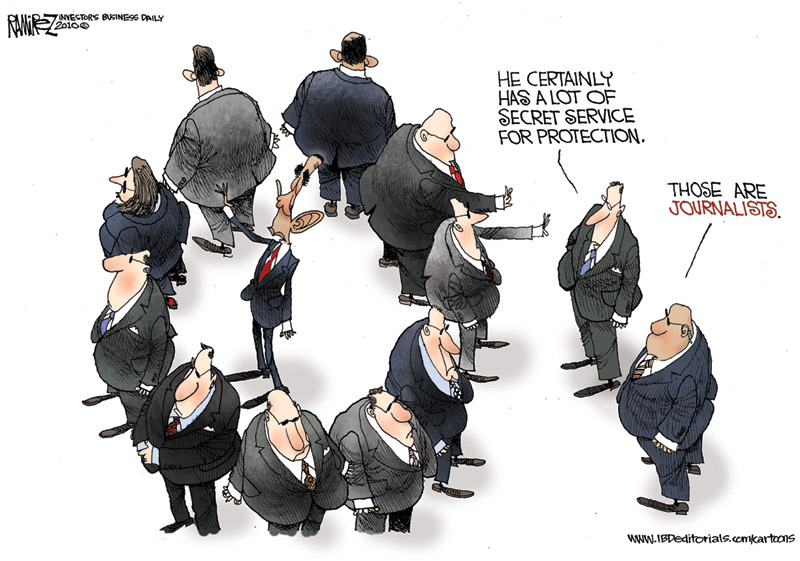
Michael Ramirez, a two-time Pulitzer Prize winner for editorial cartooning and senior editor at Investor's Business Daily, will give a free public lecture on Thursday, September 18, 2014, at 7 p.m., at Oral Roberts University in Zoppelt Auditiorium. Ramirez's lecture, "Editorial Cartooning, Journalism and a Citizen's Responsibility," is presented by three ORU departments: History, Humanities and Government; Communication, Arts and Media; English and Modern Languages.
Ramirez has been honored four times (2006, 2008, 2011, and 2014) as editorial cartoonist of the year by the National Cartoonists Society.
At noon on Friday, BatesLine is proud to host a small luncheon with Michael Ramirez. Seats are extremely limited; cost is dutch-treat. If you're interested, please email me using mailbox 'blog' at this domain.

This coming weekend, September 6 and 7, 2014, is the opening weekend of the Helmerich Center for American Research, a unit of the City of Tulsa's Gilcrease Museum. The new facility is adjacent to the museum on Gilcrease Museum Road.
A weekend full of free events is planned, including Native American and Latin American dancers, the Cherokee National Youth Choir, red dirt/Americana band The 66. There will be lectures on art and history, art-making, kite-flying, and map-reading activities for children. Food trucks will be on hand and the museum restaurant will be open. It would be easy to spend the entire weekend out there.
Legendary guitarist, singer, picker and grinner Roy Clark, fiddler Jana Jae, and the Tulsa Playboys will perform together on Saturday at 2:30 p.m. on the main stage. The event is free and unticketed; seating is first come, first served.
The Red Dirt Rangers will close out the weekend Sunday evening at 4 p.m.
Because of limited parking at Gilcrease, visitors are encouraged to park in designated lots downtown and take a five-minute shuttle ride to the museum.
MORE: Here's an earlier -- much earlier -- performance of Orange Blossom Special with Roy Clark and Tulsa Playboys bandleader Shelby Eicher. Eicher shows up about 7:40 into the video.
AFTER-ACTION REVIEW:
Our family was among those huddled under a tent as the cold drizzle continued into mid-afternoon. We were delighted to listen to the Cherokee National Choir sing songs like "Take the Name of Jesus with You," "Battle Hymn of the Republic," and "I'll Fly Away" in the language of Sequoyah. Around 2:05, a few minutes after the choir left the stage, the Tulsa Playboys began to set up. They were in place, but there was some inexplicable delay. A sound check began after the show was scheduled to start, and it was quickly apparent that the sound man had no earthly idea what he was doing.
As the rhythm section of Bob Wills and His Texas Playboys, rhythm guitarist Eldon Shamblin and drummer Smokey Dacus, along with Al Stricklin on piano, defined the beat that drove dancers across the southwestern U. S. in the 1930s from the band's home base at Tulsa's Cain's Ballroom. Dacus was on the Texas Playboys' first 1935 recording session and stayed with the band until World War II; Shamblin joined the band in 1937 and continued to work with Bob Wills off and on through the '40s and '50s. The two reunited with the rest of the early-day Playboys for a 1970 session at Merle Haggard's housewarming and Bob Wills's final recording session in December 1973, and then as the Original Texas Playboys until Stricklin's passing in 1986.
Here are Eldon and Smokey at Cain's Ballroom sometime in the early '90s, telling stories of those early days -- playing pranks, dealing with Bob Wills, Leon McAuliffe as a gawky teenager who could "fall over a broomstraw in a 60-acre field," the vast repertoire that they could play on demand as Bob read the mood of the crowd, the massive crowds they drew to Cain's (3,000 a night), playing the funerals of fans on Sunday, their only day off, and babies sleeping on the bandstand while their parents danced. Medicine Park, Crystal City, and Elwood Park (six miles south of Oklahoma City) get a mention.
Early in the conversation, Eldon said, "When you played here on Saturday night, for example, you'd look out in the crowd and there'd be people from Arkansas City, Oklahoma City... we never had a concentration of customers from Tulsa.... We always had full houses, but they weren't all from Tulsa. They were from surrounding territories."
Second in a series of reports from BatesLine's interview with Oklahoma Attorney General Scott Pruitt at Americans for Prosperity's Defending the American Dream Summit, August 29, 2014, in Dallas
When Scott Pruitt took office as Oklahoma's Attorney General in 2011, he established what he calls his special ops team, a federalism unit assigned to monitor executive orders and regulatory actions and to take legal action when a federal agency exceeds the authority granted by federal law and the Constitution.
When Pruitt sat down with the BatesLine team Friday afternoon, I asked Pruitt to name an issue his federalism unit was pursuing that might not be on the public's radar. He told me about the EPA's proposed change to the definition of what constitutes the "waters of the United States." Effectively, the EPA is seeking to expand the territory regulated by the Clean Water Act, extending federal control over local decisions regarding land use, farming, and oil and gas exploration. The proposed rule was issued in April, and the public comment period closes in October.
The EPA's authority under the Clean Water Act is tied to Congress's power to regulate interstate and foreign commerce. Historically this has meant navigable streams and significant tributaries to those streams. The proposed rule is broad enough to include drainage ditches. Ultimately nearly every square inch of territory -- lawns, rooftops, streets, storm sewers -- could act as a conduit carrying water into a navigable body of water.
Pruitt described two maps: The map of the current definition, with regulated waters in blue, was mostly white. But maps prepared by the EPA around the time it announced its proposed rule show numerous small tributaries, many of them intermittent. At the insistence of the House Science Committee, the EPA released the national map and individual state maps that had been prepared by INDUS Corporation under contract with the EPA. The map for Oklahoma in the vicinity of Tulsa shows not only major streams like Bird Creek and Mingo Creek, but tiny unnamed and intermittent tributaries of smaller creeks like Crow Creek, Swan Creek, and Mill Creek. Additionally, numerous small dots scattered across the map mark ponds. Strangely, the main stream of major rivers like the Arkansas, Cimarron, Verdigris, Canadian, and Grand are not shown.

While the EPA says that these maps were not intended to reflect Clean Water Act jurisdiction under the proposed new rule, the categories on the map line up with those in the rule.
Pruitt says that there is clearly a need for a federal arbiter like the EPA to deal with water quality and air quality issues that cross state lines. The problem comes when the EPA tries to go beyond its statutory authority and "pick winners and losers." For example, a claim of expanded jurisdiction under the Clean Water Act could be used to inhibit fossil fuels exploration and production, an indirect means to accomplish a purpose that would be rejected by our elected representatives in Congress.
Pruitt's office is filing a comment on behalf of the State of Oklahoma, and he says that other states are watching the issue and may also comment. "The EPA is saying that folks are overreacting.... We'll see. That's why they have the notice and comment process. We'll file a comment, see if they respond to it, prayerfully they'll address it and provide clarity." If the EPA moves forward with a rule that exceeds their statutory authority, the end result may be a legal challenge.
Beyond the EPA and federal/state issues, Pruitt says that water resource issues are going to be dominant for the State of Oklahoma for the next several years. In June 2013, the U. S. Supreme Court issued a unanimous decision in Tarrant v. Herrmann, upholding Oklahoma's right to protect its water resources. (Stateimpact has more on the Red River Compact and water-rights issues.)
MORE: Rob Port has written about the EPA's proposed rule and map and its impact on North Dakota. In December the Daily Caller discussed the proposed rule and EPA's claims of economic benefit.
UPDATE 2014/09/08: The U. S. House may vote Tuesday on a bill to preempt the EPA's proposed rule: The Waters of the United States Regulatory Overreach Protection Act of 2014 (H.R. 5078)
Friday, at Americans for Prosperity's Defending the American Dream Summit in Dallas, Oklahoma Attorney General Scott Pruitt sat down with the BatesLine team for a wide-ranging conversation about the issues that his office is pursuing on behalf of Oklahomans. Pruitt discussed the EPA's proposed expansion of the definition of "waters of the United States" which would put vast new territories under EPA regulation, the role and responsibilities of a state attorney general, and recent events affecting school choice and curriculum in Oklahoma. Pruitt also spoke at a panel discussion on the legal status of Obamacare and addressed a dinner for Oklahoma's 200 conferees, in which he also discussed the IRS's settlement of a lawsuit with the Freedom from Religion Foundation, affecting church tax exemptions and freedom of religion.
This entry is the first in a series. Many thanks to Americans for Prosperity Oklahoma and AFPOK Executive Director John Tidwell for the opportunity to attend and for arranging the interview with Attorney General Pruitt.
Earlier in the day, Pruitt addressed a well-attended panel session on Obamacare, its effects, and its legal status. His fellow panel members included Avik Roy of the Manhattan Institute, Christina Herrera of the Foundation for Government Accountability, and Simon Conway, British refugee and talk show host at WHO in Des Moines, who told us how the UK's National Health Service killed his father.
Pruitt spoke about Oklahoma's lawsuit, Oklahoma v. Burwell and Lew, which George Will has called the most consequential Obamacare case still pending. Oklahoma contends that the Affordable Care Act does not authorize IRS and HHS to grant subsidies or impose mandates in states that have not set up an exchange. Pruitt reviewed the timeline of Obamacare's passage and the importance of the "four little words" in Section 1311 -- "established by the state" -- to corralling the votes necessary to get Obamacare through the U. S. Senate. The four words were intended to give states the incentive to set up exchanges, but 34 states have refused.
Pruitt noted that, because Oklahoma's challenge was still at the District Court level when the Supreme Court handed down its ruling in NFIB v. Sibelius, Oklahoma was able to amend its suit. The focus of Oklahoma's case is not constitutional, but rather that the Federal Government's implementation of the law is in violation of the law passed by Congress and signed by the President.
At the moment, the case sits in the Eastern District of Oklahoma before Judge Ronald A. White. Asked by OCPAC's Charlie Meadows about the delay, Pruitt said it may be because the judge was waiting to see what the District of Columbia Circuit Court would do with Halbig v. Burwell. A panel of three judges in the DC Circuit Court ruled 2-1 that the plain language of the law authorized the subsidies and mandates only in states that established exchanges, in accord with Oklahoma's arguments. The ruling is stayed pending further appeals.
If Oklahoma's case is successful, Pruitt said that the very fines that Hobby Lobby had been facing had it lost its case ($1.2 million a day) would be overturned. The employer mandate is invalid in Oklahoma because Oklahoma has not set up an exchange.
MORE from my notes: During his morning presentation, Pruitt harked back to his service as a policymaker in the State Senate and pointed out that "health insurance does not equate to health care." Politicians like to brag about expanding coverage and eligibility, but "at the end of the day, you have to have a physician... willing to be paid for the service to deliver the care that's needed for that patient." Politicians can expand eligibility, but if reimbursement rates are too low, you have the kind of access problems we see in the UK. "We as conservatives need to remind the left that just by expanding health insurance doesn't mean that you've actually solved health outcomes." Pruitt said we also need to keep in mind that when the payor primarily becomes the government, medical inflation skyrockets.
During our interview, Pruitt elaborated on that point: The more government has become involved as payor, the system has become more bureaucratic, more costly, with a lower quality of care. He recalled Oklahoma's expansion of Medicaid eligibility under the Federal SCHIP program for families up to 200% of the poverty level, but at that time, as he remembers it, only two pediatricians in Tulsa were providing care under that program's reimbursement rates. More kids were eligible, but they couldn't get into see the doctor.
Pruitt asked why, if we had a system covering 85% of the public, we had to remake the system for 100%, rather than find a way that met the needs of the remaining 15%. The Obamacare system is moving us toward a two-tier system like that of the UK where your mandatory taxes and premiums pay for an insufficient service that limits access, but those who can afford to pay more can access higher-quality health care in a timely fashion. I pointed out that that's not unlike our two-tier education system, where parents who want better for their children pay twice -- tuition on top of the taxes they're forced to pay. That led into a discussion of Arne Duncan's revocation of Oklahoma's No Child Left Behind waiver and the court ruling against provisions of the Lindsey Nicole Henry Scholarship Act -- more about that in a future installment.
